
Pandemic Response: Rising to the challenge
Brett Ruffell
Features ProducersDocumenting poultry’s pandemic response through the eyes of different stakeholders.
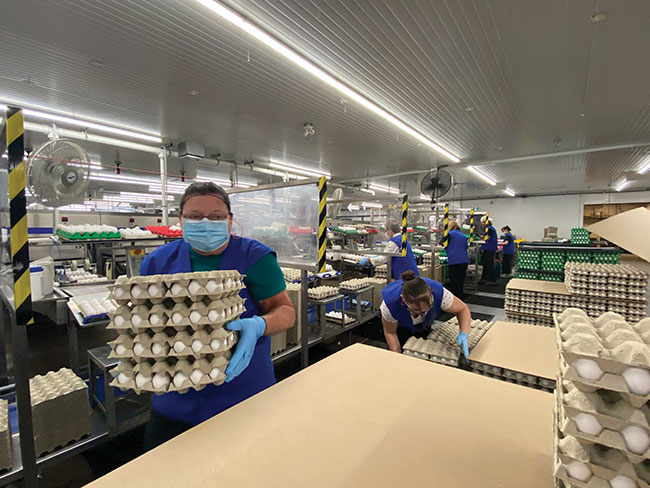 Burnbrae implemented a number of new safety protocols in response to the pandemic, included installing plexiglass barriers in between lines.
PHOTO CREDIT: Burnbrae Farms
Burnbrae implemented a number of new safety protocols in response to the pandemic, included installing plexiglass barriers in between lines.
PHOTO CREDIT: Burnbrae Farms Regardless of your sector or position, no one in poultry has been immune to the impacts COVID-19 has had on society. But as is often the case, these challenging times have brought out the best in people. In this first part of an ongoing series, Canadian Poultry talks to professionals working in different parts of the industry about how they’ve responded to the pandemic.
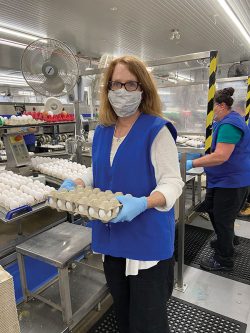
Margaret Hudson wearing PPE with a 30 flat of eggs.
Margaret Hudson, president, Burnbrae Farms
As head of one of Canada’s largest egg industry players, Burnbrae Farms’ president Margaret Hudson has quite the task on her hands leading the company through a pandemic. The business has egg grading, breaking and farming operations in five provinces across the country. And Hudson oversees Burnbrae’s strategy development and operations. Canadian Poultry spoke to her about coordinating the egg giant’s response to the virus.
What safety measures did you roll out?
We implemented a whole bunch of new safety protocols. People are wearing masks. We’re packing eggs, so most of us have to come to work. And sometimes it’s impossible to remain socially distanced. So, we put plexiglas between lines. And, obviously, we screen employees before they enter the facility.
We also enhanced our cleaning regimens, invested in PPE (personal protective equipment) and sterilized our baskets, because our industry uses a lot of returnable containers and carts. Even on the floor, we’ve worked very hard to create small cohorts. So, people are coming into very limited contact with a limited number of people.
What if an employee tests positive?
Another measure that we’ve had to follow is if someone has symptoms or has come in contact with someone who’s been COVID positive, we’ve had to do contact tracing and isolation. We followed all of the public health guidelines around that. We’ve had a few instances where we’ve had to have employees self-isolate. But through contact tracing, we managed to limit the risk to our employee base and keep everyone safe.
Up until a couple of weeks ago, we would have a call every day and we might have two or three employees at two or three locations isolating waiting for test results. And then they’re negative. We had one instance where we had three employees isolating and they all came back positive. But they came through that without any major issues and they’re back at work after eventually testing negative.
So, distancing and segmenting employees makes contact tracing easier?
Yes, because if you had someone with symptoms and you weren’t segregating people you’d have to isolate the whole plant while you waited. I think it’s been part of our success. We’ve managed to have very minimal impact operationally, and on the health and safety of our employees.
How has the testing process evolved?
Early on, it was tough because testing was difficult. You couldn’t just send employees for a test because you couldn’t get one. It was reserved for healthcare workers. And so, people had to go home for a couple of weeks and see if additional symptoms materialized. More recently, it’s a lot easier to get testing and to get results back rather quickly.
Any issues securing PPE early on?
Honestly, we had a beautiful group of volunteers that made masks. We had one of our health and safety people initiate it by making masks. And then once people realized we needed masks, I had family members making them who knew how to sew. Longer term, we deal with TNT, which is an Asian supermarket chain. And they reached out to us and said if you need PPE, we’re here to help. And we’ve actually been sourcing some of our supplies through them.
How have changes in consumer behaviour affected Burnbrae?
People were panic buying and pantry loading. And, what we saw was a massive increase in retail. And then at the very beginning of the crisis there was a temporary egg shortage and you saw empty shelves. That was because people who normally kept two dozen in their fridge suddenly had five to 10 dozen.
Also, what’s happened is carton suppliers couldn’t keep up with demand for consumer formats like cartons. So, we had to pivot very rapidly. Foodservice is trays and boxes and retail is cartons and wire baskets and carts. As a result, you’ll notice a lot more 30 trays of eggs. And that’s because there’s not enough cartons in North America to serve the rise of retail.
As a large company, what was the process like coordinating everything?
I’m so proud of our team. People worked very quickly to pull together a pandemic preparedness plan and to address the needs of not just our employees, but our operations and supply chain as well. I think the most important thing, when you’re bigger, is communication.
We really increased our messaging throughout the crisis to all of our stakeholders. We’ve had daily leadership meetings at the top of the organization as well as with all our plant leads and one or two levels down.
What charitable work has Burnbrae done since the pandemic started?
We’ve donated over 3.6 million eggs to over 30 food bank and charities coast to coast in over 3,000 communities. We just really wanted to help. We also had some issues where some product was approaching its sale date. So, we quickly pushed that out into food banks. We also wanted to support our healthcare workers. So, we donated $55,000 to 11 hospitals to help with the purchase of PPE.
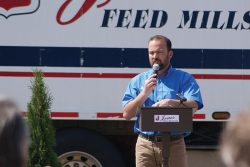
Mike Edwards and the management team at Jones Feed Mills responded early on to the pandemic with a number of strict safety regulations.
Mike Edwards, CEO, Jones Feed Mills
Jones Feed Mills Ltd. is a family owned and operated feed mill and food-grain supply business based in Linwood, Ont. With more than 130 employees, customers across North America and numerous suppliers, CEO Mike Edwards and his team faced unprecedented challenges in responding to COVID-19. Canadian Poultry spoke to him about the strict, proactive measures the feed mill took.
How did the pandemic affect your operations?
Well, it definitely had a major effect. What we started doing right away was meeting as a management team every day to discuss the new developments. We each took charge of a different aspect. All of the decisions we made followed step with what the government recommendations were.
Early on, we closed our office and our two stories to the public. And we put measures in place where basically customers contact us from outside. They can phone, email or we have a phone that they can use outside the building. We have a disinfection process for that. And they can do their business with us remotely. We offered curbside pickup fairly quickly.
You have dozens of employees. Did you make any adjustments around staffing?
Yes, for one we made everybody site specific. We have five manufacturing facilities. And for each of the teams that work in those facilities, we made them specific to that facility. So, there’s very little if any traffic between facilities. Once you’re in your workstation or the building you work in, you stay in there.
We also implemented shift changes. So, we have an actual delay of shifts. Some of our facilities are 24 hours a day and there’s a 15-minute window there for cleaning and disinfection.
In our office, we identified who could work from home. We’d normally have about 30 staff daily in here. We cut that back, too. Now, we only have eight or nine people in here each day.
Has the pandemic affected deliveries?
As far as loading trucks, we also early on excluded all outside carriers from entering any part of our facilities. They basically stay in their trucks and we do the unloading and loading. Even our own truckers don’t actually go into the mills. We have one of our staff in the middle. We’ll load them from up above so they don’t cross paths and they don’t contaminate each other’s work areas.
Did you have any issues securing PPE?
Yes, we did struggle with PPE supplies at first. And part of that was there were a number of people taking an active role in purchasing different supplies. So, we consolidated that down to one person and a very limited number of suppliers and we have it all delivered. We do a better job of that now than we did before.
Have you received any feedback from customers about the changes you’ve made to operations?
Really, for most of our customers, they wouldn’t have noticed a difference. Our sales team has been off the road. They’re only allowed to do scheduled important visits with customers. And we’re just in the process of relaxing that. We’re going to allow them to do more regular visits. Our customers have been very understanding. But they are now saying we need to have some more contact. We need to have people on the farm.
Do you have any final key takeaways from this experience thus far?
I would say this has been difficult. But we definitely are going to come out the other side of it a much stronger company. A little bit leaner, much better communication skills and a lot more understanding as far as what’s going on in the company.
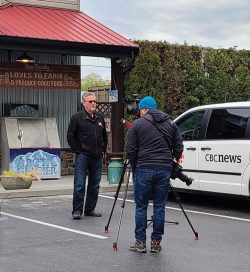
Ken Falk with camera crews discussing the COVID-19 outbreak at Fraser Valley Specialty Poultry.
Ken Falk, president, Fraser Valley Specialty Poultry
Fraser Valley Specialty Poultry is a family farm based in Fraser Valley, B.C. As the name suggests, they produce unique poultry like duck, geese and Taiwanese chicken. Early on in the pandemic, a handful of the company’s 100-plus employees tested positive for COVID-19. Canadian Poultry spoke to Ken Falk, the company’s president, about how they responded to that outbreak and what they learned from it.
Could you give us an overview of the outbreak your plant experienced?
We had a couple of people who, I suppose, came to work not feeling 100 per cent. But we can’t control where they go or what they do in the evenings. And so, they come to work maybe not feeling the best. We’re doing our prescreening like we were supposed to be doing and they weren’t demonstrating really any major symptoms – they just weren’t feeling that well.
And the one person in particular went home at noon and within a day her symptoms really started. She had gone in to have a COVID test and self-isolated on the advice of 8-1-1. And within 24 hours or so we found out that she had tested positive.
By that time a second person had begun to show some symptoms – mild but some. At that point we had all 103 staff tested. And out of that 103 we had seven positives, three of which ultimately had some symptoms while four were asymptomatic. One was more serious than the others, but none were hospitalized. They just recuperated at home.
How did the company move forward after that?
Fraser Health, our health authority, came to the plant to see what was going on and to make sure that those who were experiencing symptoms stayed home. And we said we will shut down for a day and get our bearings so that they could come in. So, we took that one day just to determine what went wrong within our systems so we knew what to fix.
Fraser Health came up with a list of risk areas that we needed to concentrate on. So, we shut down another day just to look after those things.
But, initially, we could only have about 25 per cent of our staff return for various reasons. Today, we’re running at about 70 to 75 per cent capacity. And it’s really challenging because there are so many protocols that we have to go through in terms of staff movement that takes much more time than we’re used to taking. But we’re very grateful to be running at the rate that we are.
If you could turn back the clock to the early days of the pandemic, what would you do differently?
I suspect one of the first things we would do is make it mandatory for everybody in the plant to wear masks. At first, we were being told that masks don’t do any good. Now, we’re being told the opposite.
Are you doing anything differently around cleaning and disinfecting?
Yes, previously we were doing an evening cleanup where we would have our staff do a complete cleaning of the facilities, including shared areas like lunch rooms and washrooms. Now, we have several full-time staff where the only thing they do all day long is continuously wipe down high contact surfaces. And so that’s a new cost of doing business.
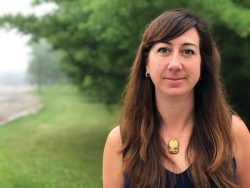
Ashley Honsberger started with the Poultry Industry Council shortly before the pandemic.
Ashley Honsberger, executive director, Poultry Industry Council
In December, Ashley Honsberger became the new executive director of the Poultry Industry Council (PIC). Only a few months into her new role, the meetings and events world in particular was turned upside-down by the pandemic. Canadian Poultry spoke to her about being baptized by fire and having to make big decisions right off the get-go.
It wasn’t long into your tenure with PIC that COVID hit. What was that experience like?
The first hurdle for us was that we were approaching the April timeframe of hosting the National Poultry Show, which is, of course, a massive event where everybody gets together and shakes hands and hugs and catches up. So, that was probably the biggest decision as far as is it a go or not. Because, really, nothing at that point had been cancelled quite to that extent.
So definitely, it was a huge challenge. It’s taking ownership of this precious thing that’s been built by the industry over the years. For me to have to walk in and start saying, okay, we have to stop doing significant events and initiatives. It was definitely a huge challenge.
But I think the thing I really appreciated was that the whole board was supportive. And we had a ton of calls. I called my chair probably two to three times a day leading up to decision-making day. It’s just amazing to see everybody pull together and make the right decision at the right time.
What was the process like around deciding whether to postpone this year’s event or cancel it all together?
At first, in my ignorance, I thought maybe this will pass. But then once we realized it wasn’t going to happen over the summer, we didn’t want to impact other things that perhaps were happening. And we didn’t want to take away from the experience the National Poultry Show normally brings. And so just to host it and not know if it would be a safe environment for everybody – it just didn’t sit well with everybody. So, ultimately, that’s why we cancelled.
Did you consider making it a virtual event instead?
We definitely talked about it. At that time, could we pull off a virtual event this year? I just don’t think that we had our heads wrapped around what that would look like. But definitely since then, we’ve been talking to Western Fair about having a virtual option available for the show, regardless of what happens next year. That way, people from across Ontario and Canada could participate in the show without necessarily having to travel.
When do you foresee returning to live events?
I don’t know. It’s very up in the air. Personally, I take a bit of a pessimistic view because I, fortunately, have access to scientists who work at the University of Guelph. They’ve been doing quite a few op-eds around how challenging the notion of a vaccine is, particularly with this type of virus, and how challenging the idea of herd immunity is. So, I’m not sensing that there’s going to be a silver bullet. And I know that’s really challenging for people. But knowing that maybe it’s not going to be very rosy for the next six to 12 months, I think we can prepare ourselves and the community.
Print this page